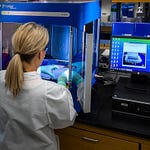Hey everyone!
I spent the evening yesterday diving deep into the White House's new memorandum on AI and national security (Fact Sheet, Deep Dive), and I've got to tell you – this is one of the most significant policy developments I've seen in our field. Let me break down why I'm so excited about this and what it means for the future of AI, biotechnology, and national security.
It wouldn’t be me without an AI-generated podcast for your listening pleasure. I’m actually pretty impressed with all 18 minutes of this one.
A New Era of AI Governance
First off, this isn't just another policy document – it's a comprehensive framework that fundamentally reshapes how the U.S. government approaches AI in national security. What's particularly striking to me is how it balances the urgent need to advance AI capabilities while establishing robust safeguards for safety, security, and democratic values.
The timing couldn't be more critical. As someone who's been working at the intersection of AI and life sciences, I've seen firsthand how rapidly these technologies are evolving and their potential implications for both innovation and security.
Three Key Pillars That Matter
The memorandum establishes three main objectives that I think are particularly noteworthy:
Leading in Safe AI Development: The U.S. is making a clear commitment to lead in developing safe, secure, and trustworthy AI. This isn't just about being first – it's about being right. They're emphasizing partnerships between government, industry, academia, and civil society (something I've long advocated for in the life sciences space).
Harnessing AI for National Security: There's a pragmatic recognition that AI offers profound opportunities for enhancing national security, but only with appropriate safeguards. What excites me here is the emphasis on understanding AI's limitations while harnessing its benefits.
Building International Framework: This might be the most forward-thinking aspect – the commitment to developing a stable, responsible framework for international AI governance. We're seeing a clear vision for how AI development can align with democratic values and human rights.
Biosecurity and AI: A Critical Focus
What really caught my attention (and what I think many of you will find interesting) is the specific attention paid to biological and chemical security. The memorandum calls for:
Development of tools for screening in silico chemical and biological research
Creation of new algorithms for nucleic acid synthesis screening
Construction of high-assurance software foundations for novel biotechnologies
This is exactly the kind of forward-thinking approach we need to ensure AI advances in life sciences remain both innovative and secure. And go figure, it’s not all about the scary, its about doing the awesome responsibly. Love it.
What This Means for Our Field
For those of us working in life sciences and AI, this memorandum has several important implications:
Enhanced Collaboration: There's a clear push for better coordination between government agencies, research institutions, and private sector partners. This could open up new opportunities for cross-sector collaboration.
Safety Testing Framework: The establishment of the AI Safety Institute (AISI) within NIST as the primary testing body for AI systems is a game-changer. This gives us a clear pathway for evaluating AI systems in life sciences applications.
Talent Development: The memorandum emphasizes the need to attract and retain AI talent – something that's crucial for advancing responsible innovation in our field.
What's Next?
This is just the beginning of what I expect will be a transformative period in AI governance. The memorandum sets ambitious timelines for implementation, with many key deliverables due within the next 180 days.
Here's what I'm watching closely:
The development of specific biosecurity evaluation frameworks
Implementation of the new AI governance structures
Evolution of international partnerships and standards
Getting Involved
For those of you wanting to engage with these developments:
Consider participating in upcoming NIST workshops and public comment periods
Look for opportunities to contribute to the development of safety testing frameworks
Stay engaged with your professional societies as they develop responses to these new guidelines
Final Thoughts
This memorandum represents a watershed moment in AI governance. It's ambitious, comprehensive, and – most importantly – actionable. While there's still much work to be done, I'm optimistic about the framework it establishes and its potential to shape responsible AI innovation in life sciences and beyond.
What aspects of the memorandum most interest you? I'd love to hear your thoughts and continue this discussion.
Stay curious and keep innovating.
Cheers,
-Titus
Want to dive deeper into specific aspects of the memorandum? Let me know what topics you'd like me to explore in future newsletters.
The podcast audio was AI-generated using Google’s NotebookLM












Share this post